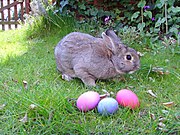
March’s full Worm Moon reaches peak illumination at 2:50 P.M. EDT on Sunday, March 28, 2021.
Look for the spectacularly bright Moon as it rises above the horizon that evening! See when the Moon will be visible in your area.
This year, because it is the first full Moon to occur after the spring equinox on March 20, March’s full Moon is the Paschal Full Moon. This means that its date determines the date of Easter (April 4, 2021)! Read more about how Easter’s date is determined.
WHY IS IT CALLED THE WORM MOON?
The full Moon names used by The Old Farmer’s Almanac come from a number of places, including Native American, Colonial American, and European sources. Traditionally, each full Moon name was applied to the entire lunar month in which it occurred, not only to the full Moon.
The Worm Moon
March’s full Moon goes by the name Worm Moon, which was originally thought to refer to the earthworms that appear as the soil warms in spring. This invites robins and other birds to feed—a true sign of spring!
An alternative explanation for this name comes from Captain Jonathan Carver, an 18th-century explorer, who wrote that this Moon name refers to a different sort of “worm”—beetle larvae—which begin to emerge from the thawing bark of trees and other winter hideouts at this time.
Here’s a video on the Full Worm Moon from The Old Farmer’s Almanac, featuring Amy Nieskens:
*



